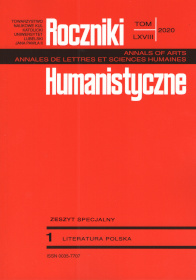Women in the Works of Karol Wojtyła / John Paul II
Abstract
This article consists of two parts. The first part focuses on the thoughts of the Pope, which we can treat as the author’s context and which is necessary for analysing the papal poetic meditations. The analyses are included in the second part. The context is made up of statements from the early period of the pontificate, which should be considered the most important in the teachings of the Holy Father about women. I am referring here to the following editions of John Paul II’s teachings: Vol. 1: He created man and woman. Christ refers to the “origin”: John Paul II’s theology of the body, Vol. 4: The Sacrament and Vol. 8: Familiaris Consortio: On the Role of the Christian Family in the Modern World, as well as the apostolic letter Mulieris Dignitatem: On the Dignity and Vocation of Women on the Occasion of the Marian Year. The aforementioned texts are the relevant basis for studying the papal poetic output, because, like the poetry of John Paul II, they capture woman in the metaphysical, spiritual and divine categories. Such an interpretational basis is not provided by feminism or even John Paul II’s project of new feminism, whose main and laudable concern was to restore woman’s personal dignity in the social dimension. The most important views on women in the papal teaching refer to the Book of Genesis, to the descriptions of the creation of the human being – a woman and a man who become, in the words of the Holy Father, one body, one heart and one spirit. It is in this paradigm, in the “sacrament of creation” (in union with a man) that a woman attains the highest status in the metaphysical and personalistic dimensions. This is confirmed by the meditation in Part 2 of the Roman Triptych. However, the universality of this anthropological paradigm means that it also applies to other texts whose protagonists are women themselves: Mary Magdalene, the Samaritan woman, Veronica, or the girl disappointed in love. The current study is limited to poetry. Undoubtedly, of great importance from the point of view of women’s issues is the interpretation of the drama In front of the Jeweller’s Shop: A Meditation on the Sacrament of Matrimony, Passing on Occasion into a Drama. This play will become the subject of a separate study.
References
Adamiak, Elżbieta. „Nowy wiek i feminizm”. Kobieta w nowym wieku, red. Jacek Bolewski, Wydawnictwo WAM, 2001.
Bolewski, Jacek. Biała bogini, czarna madonna. Maryjne światło w ezoterycznym odcieniu. Wydawnictwo „Rhetos”, 2005.
Chudy, Wojciech. „Oblicza personalizmu i ich konsekwencje”. Kwartalnik Filozoficzny, t. XXVI, z. 3, 1998.
Hołub, Grzegorz. „Kobiecość i męskość w spełnieniu osoby w ujęciu Karola Wojtyły”. Wokół antropologii Karola Wojtyły, red. Andrzej Maryniarczyk, Paulina Sulenta i Tomasz Duma, Polskie Towarzystwo Tomasza z Akwinu. Katedra Metafizyki KUL, 2016, ss. 395–406.
Pismo Święte Starego i Nowego Testamentu, t. 1–3, Ksiegarnia św. Wojciecha, 1973–1975 [tzw. Biblia Poznańska].
Plus Raoul J. Szaleństwo krzyża. Wydawnictwo Księży Jezuitów, 1947.
Półtawska, Wanda. „Wstyd i wstydliwość jako afirmacja tajemnicy”. Jan Paweł II. Mężczyzną i niewiastą stworzył ich. Chrystus odwołuje się do „początku”. O Jana Pawła II teologii ciała, Jan Paweł II naucza, t. 4, Redakcja Wydawnictw KUL, 1981, ss. 203–215.
Sawicki, Stefan, [głos w dyskusji w tomie:] Jan Paweł II. „Familiaris consortio”. Tekst i komentarze, Jan Paweł II naucza, t. 8, red. Tadeusz Styczeń, Redakcja Wydawnictw Katolickiego Uniwersytetu Lubelskiego, 1987, ss. 282–283.
Styczeń, Tadeusz. „Ciało jako «znak obrazu Stwórcy»”. Jan Paweł II. Mężczyzną i niewiastą stworzył ich. Chrystus odwołuje się do „początku”. O Jana Pawła II teologii ciała, Jan Paweł II naucza, t. 4, Redakcja Wydawnictw KUL, 1981, ss. 85–138.
Styczeń, Tadeusz. „Istota więzi małżeńskiej w perspektywie filozoficzno-teologicznej”. Jan Paweł II.
„Familiaris consortio”. Tekst i komentarze, Jan Paweł II naucza, t. 8, red. Tadeusz Styczeń, Redakcja Wydawnictw Katolickiego Uniwersytetu Lubelskiego, 1987, ss. 123–142.
Copyright (c) 2020 Roczniki Humanistyczne

This work is licensed under a Creative Commons Attribution-NonCommercial-NoDerivatives 4.0 International License.





